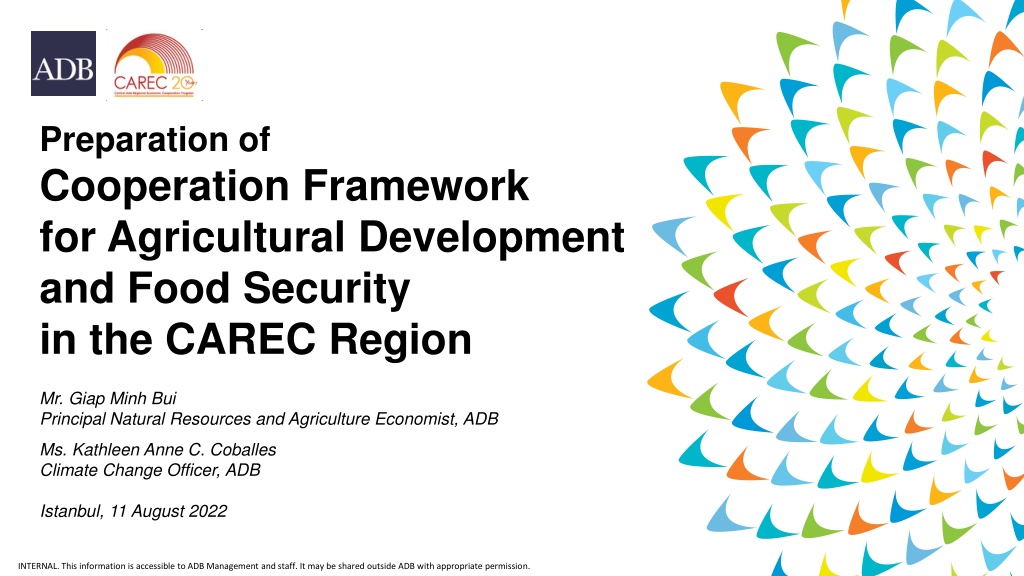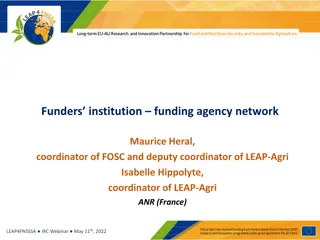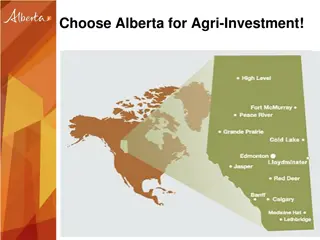Challenges and Opportunities for Agricultural Development in the CAREC Region
Addressing the increased risks to food security in the CAREC countries due to factors like underdeveloped agriculture, climate change, and geopolitical conflicts. Constraints such as low productivity, lack of investment, and weak infrastructure hinder sector growth, necessitating a cooperation framework for sustainable development.
Download Presentation

Please find below an Image/Link to download the presentation.
The content on the website is provided AS IS for your information and personal use only. It may not be sold, licensed, or shared on other websites without obtaining consent from the author. Download presentation by click this link. If you encounter any issues during the download, it is possible that the publisher has removed the file from their server.
E N D
Presentation Transcript
Preparation of Cooperation Framework for Agricultural Development and Food Security in the CAREC Region Mr. Giap Minh Bui Principal Natural Resources and Agriculture Economist, ADB Ms. Kathleen Anne C. Coballes Climate Change Officer, ADB Istanbul, 11 August 2022 INTERNAL. This information is accessible to ADB Management and staff. It may be shared outside ADB with appropriate permission.
Outline Rationale for the preparation of the Framework Proposed scope of the Framework Proposed approach to the preparation of the Framework Preliminary timetable for the preparation of the Framework INTERNAL. This information is accessible to ADB Management and staff. It may be shared outside ADB with appropriate permission.
Increased risk to food security in the CAREC countries (availability, accessibility, and utilization) The CAREC countries are facing increased risks to food security Factors adversely affecting food security in the CAREC countries include: - Underdevelopment of agriculture - Traditional market and marketing - Climate change - COVID-19 pandemic - Geopolitical conflict in Ukraine INTERNAL. This information is accessible to ADB Management and staff. It may be shared outside ADB with appropriate permission.
Fundamental Constraints to Agriculture Sector Growth Low productivity (land, labor, and capital) Low total factor productivity (outdated technologies and slow innovation catch-ups in production, processing, and marketing) Lack of investment in human capital and limited entrepreneurship Inadequate requisite infrastructure and market systems Lack of incentive for private sector participation Weak resilience to market volatility and climate change Lack of conducive institutional and legal/regulatory environment COVID-19 pandemic and geopolitical conflict in Ukraine (impacts on both demand and supply sides) INTERNAL. This information is accessible to ADB Management and staff. It may be shared outside ADB with appropriate permission.
Fundamental Constraints to Agriculture Sector Growth: Macro Level Illustration Agriculture Sector in the Aggregate Demand and Supply (AD-AS): Simplified Visualization Price/ Cost Long-run Short-run Aggregate Supply (SRAS) (WITH sector constraints) Aggregate Supply (LRAS) E Short-run Aggregate Supply (SRAS) (Key sector constraints relaxed) P/C1 A P/C2 B D Aggregate Demand (AD) C 0 Sector GDP1 Sector GDP2 (Expected, at full potential or 35-40% of national GDP, other things constant) (Current, 17-28% of national GDP) INTERNAL. This information is accessible to ADB Management and staff. It may be shared outside ADB with appropriate permission.
Modernizing Value Chain to Enhance Food Security on Market Principles More private sector investment enabled for cluster business, aggregation, processing, and value-added services Key Characteristics: Modern Value/Supply Chain Traditional Agricultural Marketing Key Characteristics: Producer Producer Production-Oriented Consumer - oriented Export Focus on processes Fragmented Production units Increased profitability for farmers and agribusiness enterprises (due to lower transport cost (10-15%), higher crop yield (at least 10%), and lower post harvest losses (15-20%) Wholesaler Differentiated product Farm level buyer (agents/assemblers) Multi-layered channels Grading and private New Shipper (packing house) Undifferentiated Products labeling Retailer (conventional GS, CS, ) Export Food safety Focus on Distributive function Wholesaler Traceability Import New retailer (SM, SMC, HM, warehouses) Import Minimal Grading Value creation Retailer (groceries) More local jobs created, purchasing power increased, and urban migration reduced Predominance of Minimal Value-added retailer Consumer Integrated structure, physical, information & control Predominance of wholesaler Consumer Producer- Pushed Market Consumer-Pulled Market Logistics as backbone Government tax revenue increased and investment in human capital (health and education) enabled GS = Grocery Stores CS = Convenience store SM = Supermarket SMC = Supermarket chain HM = Hypermarket ICT as enabler Global outsourcing INTERNAL. This information is accessible to ADB Management and staff. It may be shared outside ADB with appropriate permission.
Prerequisites for Strengthening Agriculture Value Chain DOMESTIC OVERSEAS PROCESSING / VALUE-ADDING DISTRIBUTIVE TRADE INTERNATIONAL TRADE PRODUCTION INPUTS Raw materials / intermediate goods IMPORTS Bulk / Pre-packed Bulk / components C O N S U M E R Distribution & storage Processor / Value- Adding Collection Farmer / Producer Seeds Wholesaler Retailer Agro-chemicals Small farmer / producer Main product Farm Equipment Group farming /Contract farming Institutional Buyer Farm Machinery Co-products By-products Other Inputs Large scale production STOCKPILING Wastes EXPORTS PREREQUISITES FOR ENHANCING VALUE CHAIN Institutional and legal/regulatory frameworks for PPPs and innovative financing Research and development, and efficient extension services Agricultural market information, branding and marketing Access and productive infrastructure Other country- specific factors Vibrant agribusinesses and aggregators Product quality and safety standards (functional and internationally harmonized) INTERNAL. This information is accessible to ADB Management and staff. It may be shared outside ADB with appropriate permission.
Climate change impacts on Agricultural Productivity and Food Security (1/2) Agricultural productivity in the CAREC region is acutely threatened by the impacts of climate change, including decreasing water supply, flooding, heatwaves/droughts and pests & diseases Global: decline in crop yields wheat 5% and corn 6% CAREC region: decline in yields ranging from 3% to 10% for major crops (wheat, rice, and corn) At 2 C global warming, snowmelt water availability (dependent on river basins) for irrigation to decline by 20% Reduced animal and livestock health and productivity due to heat stress and diseases Climate change affects food security in all its dimensions: availability, accessibility, utilization and stability INTERNAL. This information is accessible to ADB Management and staff. It may be shared outside ADB with appropriate permission.
Climate change impacts on Agricultural Productivity and Food Security (2/2) Practical adaptation and mitigation measures for the CAREC region: Improved crop land management (e.g., climate-friendly agricultural inputs) Sustainable and efficient livestock systems Water use efficiency and water resource management Carbon sequestration measures Reduction of CH4 and N2O emission (from crop and land management burning, fertilizer usage, and manure management) Reduction of food loss and food waste INTERNAL. This information is accessible to ADB Management and staff. It may be shared outside ADB with appropriate permission.
The Need for the Framework Many ongoing and planned CAREC activities (country-specific and regional) have, will have, or can have positive impacts on agricultural development and/or food security in the CAREC countries The Framework is needed to: align these activities more closely with the priorities of the governments of the CAREC countries with regard to agricultural development and food security; increase synergies among the activities and enhance value addition; magnify their positive effects on agricultural development and food security in the CAREC countries; and enhance regional cooperation in agriculture development and food security INTERNAL. This information is accessible to ADB Management and staff. It may be shared outside ADB with appropriate permission.
Proposed Scope of the Framework The scope of the Framework will encompass the following themes: Productivity, Sustainability, and Value Chain Agriculture Trade and Finance Private Sector and Public-Private Partnerships Some prospective areas for regional cooperation may include, but not limited to, the following: Modern agricultural technologies (including green technologies) and farming practices Modernization of sanitary and phyto-sanitary (SPS) measures and food quality systems Modernization of customs administration and border management to facilitate trade in food products Development of agricultural extension services and food value chains, in particular, through public-private partnerships (PPPs) and use of digital technologies INTERNAL. This information is accessible to ADB Management and staff. It may be shared outside ADB with appropriate permission.
Proposed Approach to the Preparation of the Framework The Framework will be prepared in two steps: Step 1: Preparation of a background report on agricultural development and food security in the CAREC Step 2: Preparation of the draft Framework based on the background report The draft Framework will be presented to the next CAREC Ministerial Meeting for endorsement INTERNAL. This information is accessible to ADB Management and staff. It may be shared outside ADB with appropriate permission.
Proposed Approach to the Preparation of the Framework (1) The background report will: review the agriculture and food security landscape, including relevant government policies and priorities, in the CAREC countries review ongoing and planned CAREC activities pertaining to agricultural development and/or food security identify prospective PPP models on regional interoperable smart and/or digital technologies that can enhance food production, market links, green financing and green trade provide recommendations on the prioritization of the planned CAREC activities and, possibly, on additional CAREC activities INTERNAL. This information is accessible to ADB Management and staff. It may be shared outside ADB with appropriate permission.
Proposed Approach to the Preparation of the Framework (2) The background report will be prepared through a combination of: a desk review of literature, documents of the government of the CAREC countries, and CAREC and ADB documents compilation and analysis of secondary data from online sources consultations with key stakeholders, including the governments of the CAREC countries, the private sector and development partners INTERNAL. This information is accessible to ADB Management and staff. It may be shared outside ADB with appropriate permission.
Preliminary Timetable Jun-22 Jul-22 Aug-22 Sep-22 Oct-22 Activities H2 H1 H2 H1 H2 H1 H2 H1 Review of literature and government/CAREC/ADB documents Compilation and analysis of secondary data from online sources Consultations with key stakeholders Preparation of the first draft of the background report Preparation of the final draft of the background report Preparation of the draft Framework INTERNAL. This information is accessible to ADB Management and staff. It may be shared outside ADB with appropriate permission.
Tentative Next Steps The Framework endorsed by the CAREC Ministerial Meeting in Q4 2022 CAREC Strategy for Agriculture Development and Food Security prepared by Q1/Q2 2023 Knowledge and Support Technical Assistance approved by Q2 2023 to support implementation of the regional agriculture and food security agenda (subject to endorsement of the Strategy) INTERNAL. This information is accessible to ADB Management and staff. It may be shared outside ADB with appropriate permission.
Questions for discussion: 1. What are the main issues hindering agricultural development and food security in the CAREC countries? 2. What are the policies and priorities of the governments of the CAREC countries with respect to agricultural development and food security? 3. What opportunities exist for public-private partnerships and adoption of modern technologies that would contribute to agriculture modernization and enhance food security in the CAREC countries? 4. What CAREC activities are, can be or could be effective in helping the CAREC countries meet their needs in agriculture modernization and food security? INTERNAL. This information is accessible to ADB Management and staff. It may be shared outside ADB with appropriate permission.























